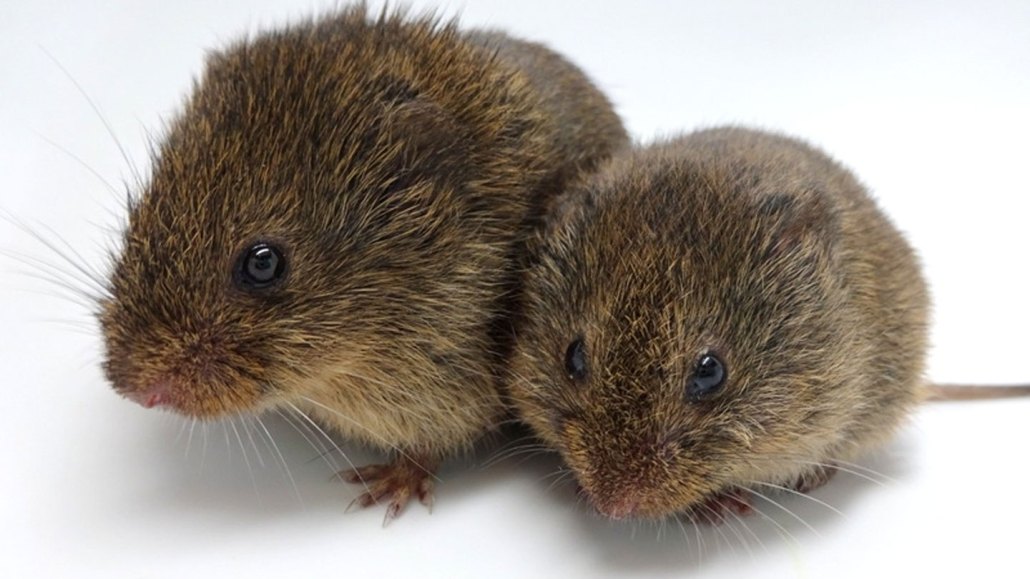Prairie voles can couple up even without the ‘love hormone’
The rodents don’t need the hormone oxytocin to find mates

This is a pair of prairie voles (Microtus ochrogaster). They form life-long bonds with their mates. New research suggests the hormone oxytocin is important for this bonding — but not required.
Nastacia Goodwin
Share this:
- Share via email (Opens in new window) Email
- Click to share on Facebook (Opens in new window) Facebook
- Click to share on X (Opens in new window) X
- Click to share on Pinterest (Opens in new window) Pinterest
- Click to share on Reddit (Opens in new window) Reddit
- Share to Google Classroom (Opens in new window) Google Classroom
- Click to print (Opens in new window) Print
Prairie voles love a fairy-tale ending. Many rodents mate with more than one partner during their lives. Not prairie voles. These little mammals pair off for life. For a long time, scientists thought voles needed a chemical called oxytocin (Ox-ee-TOH-sin) to find their happily ever after. A study now suggests it may not be so necessary after all.
For decades, scientists thought oxytocin was required for pair-bonding. The new result doesn’t throw out decades of past work. It just means there can be a bit more to explaining the love lives of voles.
Biologists have studied prairie-vole mating for more than 40 years, notes Devanand Manoli. He’s a biologist at the University of California, San Francisco. Scientists would capture voles (Microtus ochrogaster) to study. They found themselves often catching two at a time. “What they were finding were these male-female pairs,” Manoli explains.
Pair-bonded prairie voles prefer each other’s company to that of a stranger’s. They like to snuggle together both in the wild and in the lab. Other vole species don’t have such complex social behaviors. So scientists have studied prairie voles to try to understand how social behavior evolves.
Love chemistry
Over time, scientists turned up several chemicals needed to make the prairie voles pair off. As hormones, these particular chemicals move through the blood to send messages. The most well-known is oxytocin. This hormone plays an important role in social behavior in humans and other animals. Past studies in voles used drugs to block a receptor — a chemical docking station — that allows oxytocin to affect cells. When the oxytocin receptor was blocked, voles would leave their partners in the lurch.
Manoli and his colleagues thought the oxytocin receptor would be the perfect target for CRISPR. This is a tool used to edit an organism’s genes. The researchers used the technique on vole embryos. Affected animals were born without functioning oxytocin receptors.
The team figured that these rodents wouldn’t be able to form pair bonds. That was, after all, what past experiments showed in voles whose oxytocin activity was blocked with drugs. Instead, Manoli says, the researchers got “a big surprise.” The voles could form pair-bonds even without oxytocin. The team’s findings appeared March 15 in Neuron.
“I was very surprised,” says Larry Young. He’s a biologist at Emory University in Atlanta, Ga. Though he wasn’t part of this study, Young has studied oxytocin in prairie voles for decades.
Timing is key
Voles don’t form pair bonds after getting drugs that block oxytocin. But those with CRISPR-edited oxytocin receptors still do. Why the different outcomes? It could be the timing of when oxytocin’s activity is turned off.
The oxytocin-blocking drugs were given to adults. Those voles would have already had exposure to oxytocin in their brains before the shutoff. But with CRISPR, “these animals are born never experiencing oxytocin signaling in the brain,” explains Young. His research group has recently repeated Manoli’s experiment and found the same thing.
Maybe voles become dependent on oxytocin for pair bonding as their brains develop, Young says. Think of it like a symphony that is used to following a conductor. Each player in the symphony has always followed the conductor to know when to play. If the conductor leaves, the members of the symphony may all begin to play things at different times. Now think of a rock band. Most rock bands don’t have conductors. Because they’ve never had one, they work just fine without one.
Manoli agrees that the technique’s timing matters. But many drugs can bind to more than one molecule in the brain. Manoli worries that the drugs scientists used to block oxytocin could have been doing other things in the vole brains that had an effect on pair-bonding.
“I don’t believe that,” Young says. “The [drug] that people use is very selective.” It doesn’t even bind to the receptor of oxytocin’s closest chemical relative.
The seemingly startling new result makes sense if you look at the big picture, Manoli says. The ability of voles to pair-bond is “critical for the survival of the species,” he says. If a behavior is that important, he explains, it’s unlikely that just one molecule would be responsible.
His group now hopes to look at how other hormones affect pair-bonding. They also are looking more closely at the voles’ behavior, just in case CRISPR’s gene editing changed it in a way they haven’t noticed yet.
Manoli says these new data show that what makes voles pair-bond “is a much more complicated question” than they had realized. The drug studies “suggested that [oxytocin] plays a critical role. The question is: What is that role?”







